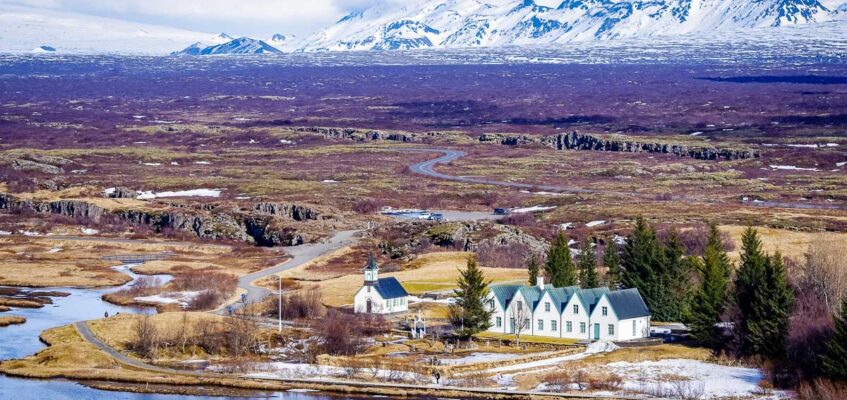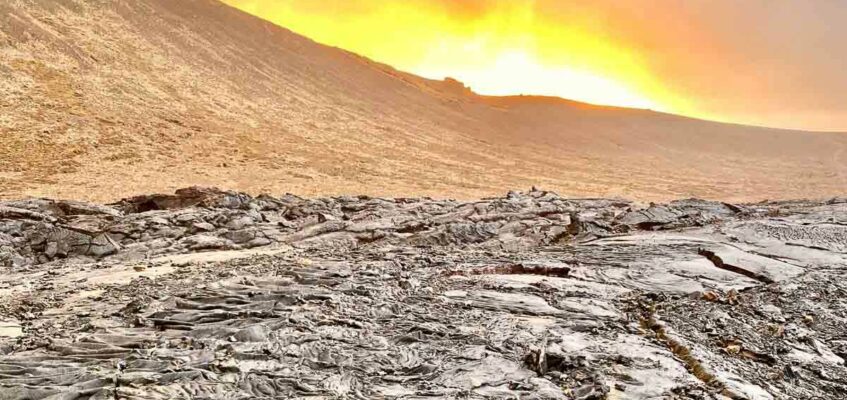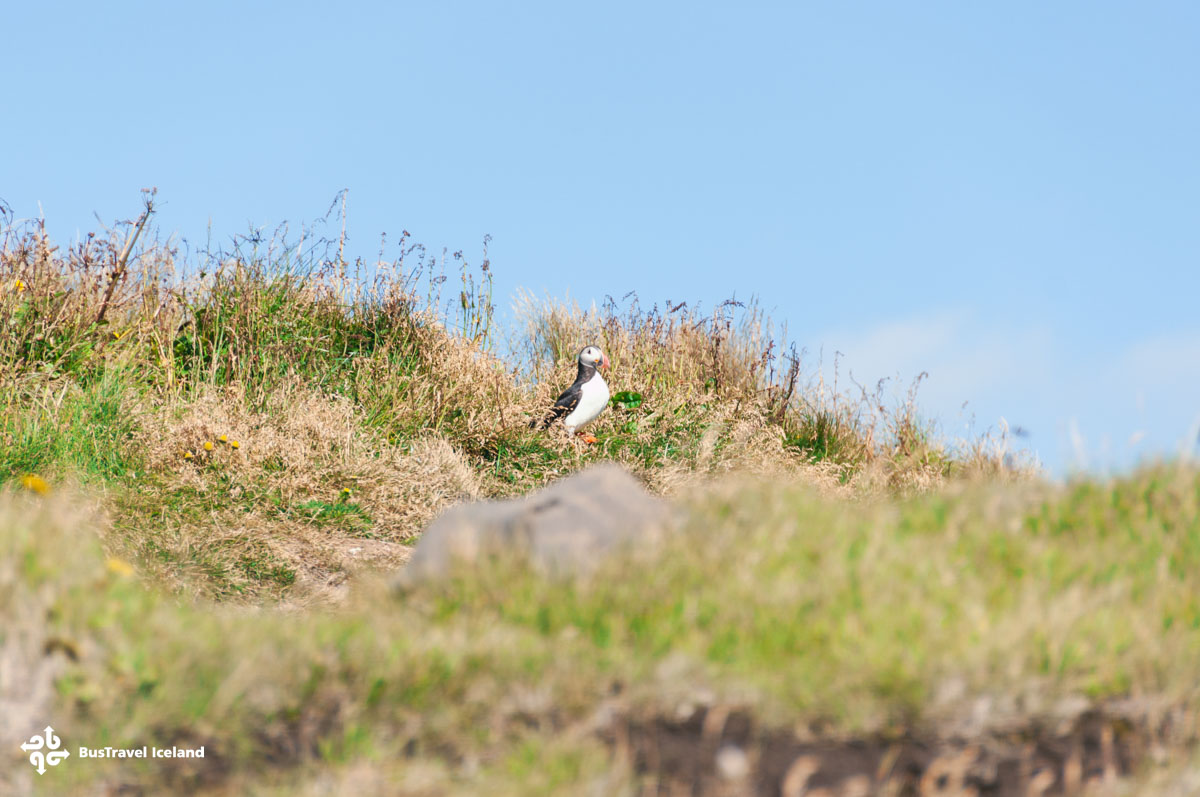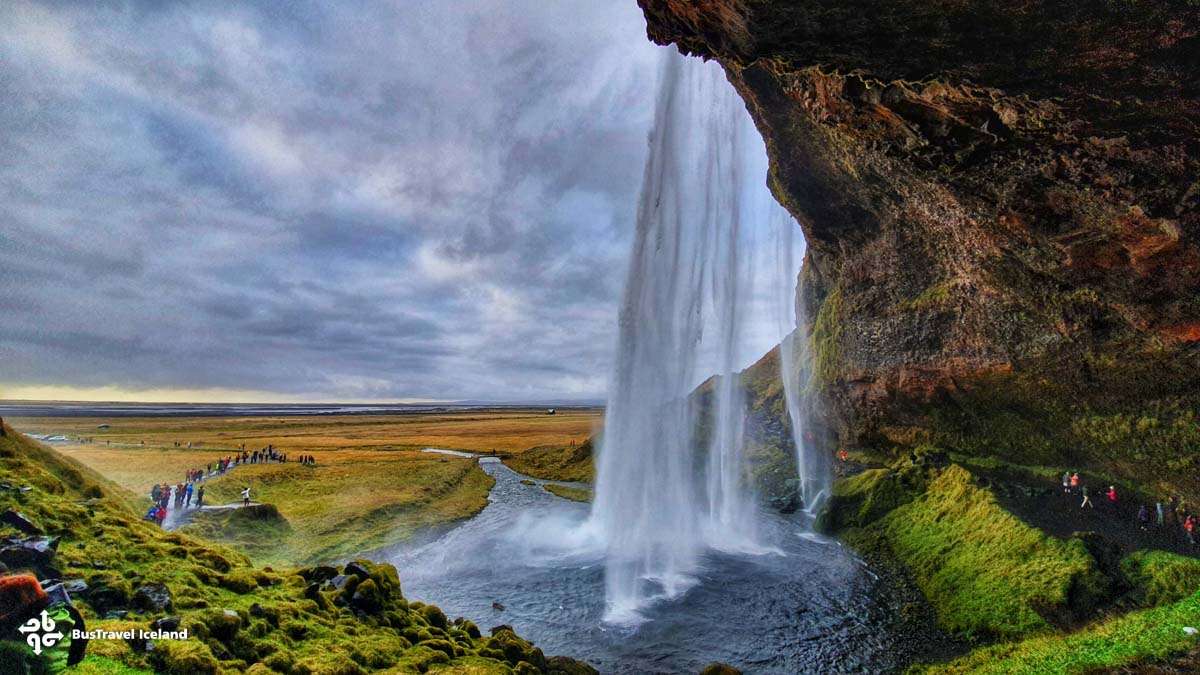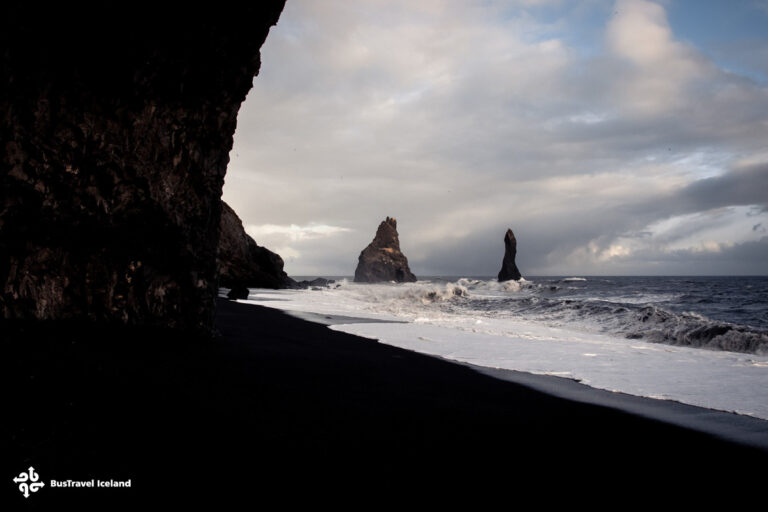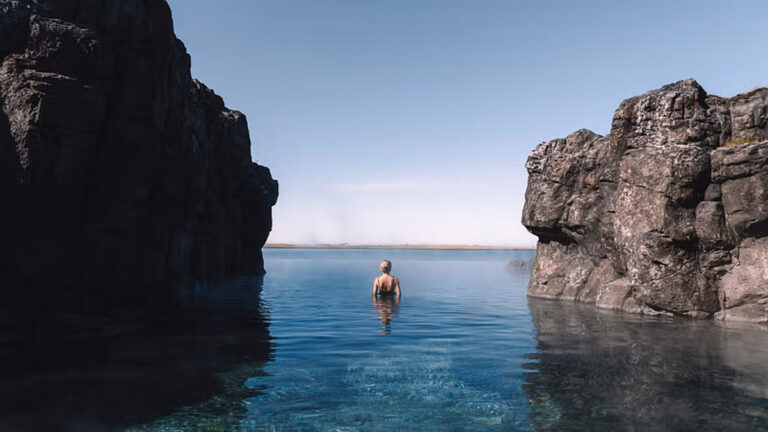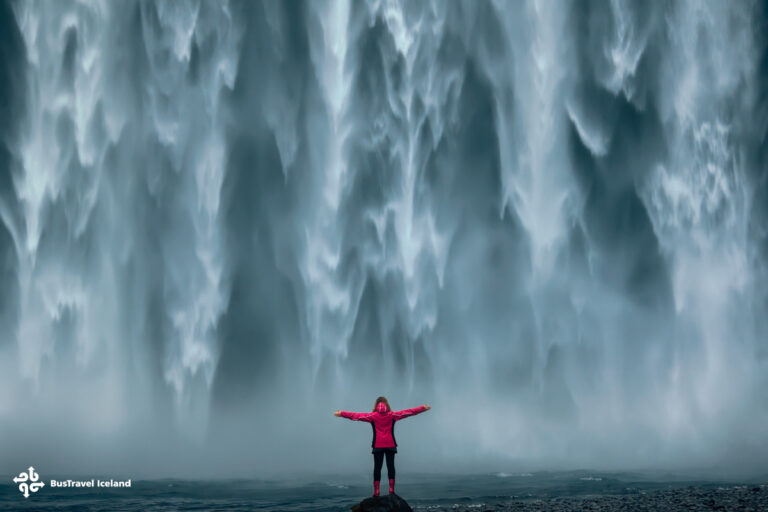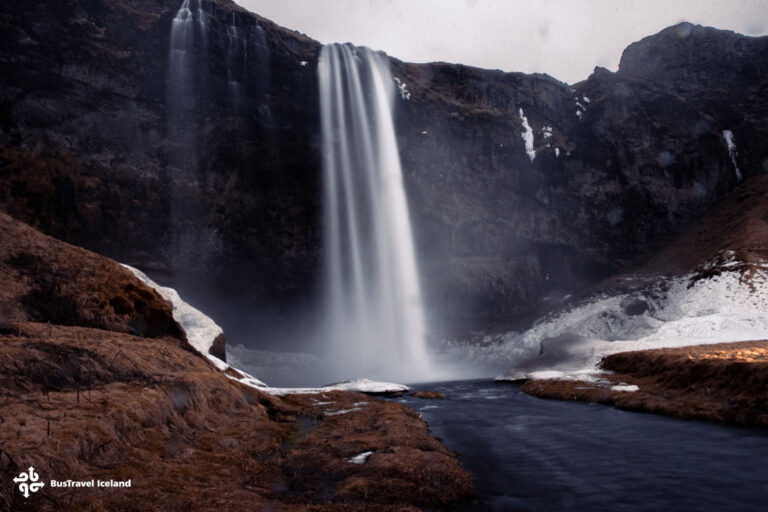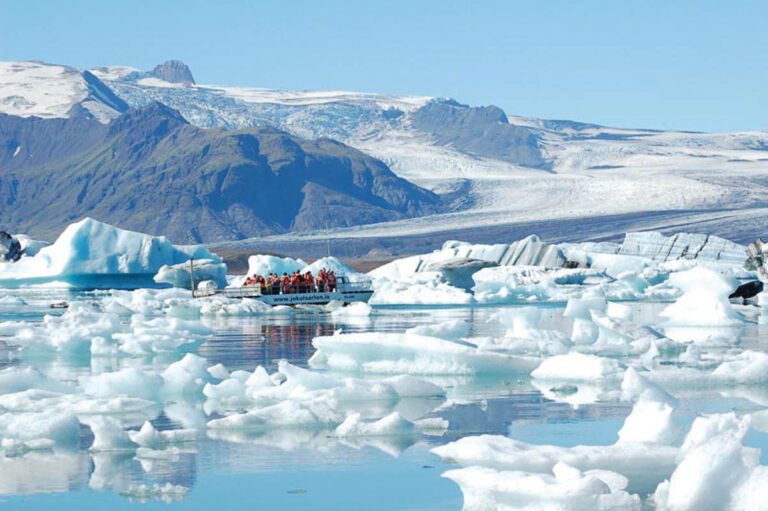Dyrhólaey Arch: Nature’s Majestic Gate
- South Iceland
- 4 Jul 2023
South Iceland homes a collection of remarkable landmarks, among which is the Dyrhólaey Peninsula, a beautiful destination filled with unforgettable highlights and wonderful sights.
![Dyrhólaey Arch in South Iceland [Photo credit to Yanshu Li]](https://bustravel.is/wp-content/uploads/2023/07/Dyrholaey-Arch-South-Iceland-7340.jpg)
The Dyrhólaey Arch is situated on the southernmost tip of the Dyrhólaey Peninsula, a short distance from the charming seaside village of Vík í Mýrdal. With its volcanic origins, Dyrhólaey was once an island before it became connected to mainland Iceland. Its name, “dyrhólaey,” translates to “door hill island” in English and it was formerly known to seafarers as Cape Portland.
Rising proudly from the black volcanic cliffs, the arch serves as a gateway between land and ocean, captivating visitors with its dramatic presence. Its precise coordinates are approximately 63.4049° N latitude and 19.0727° W longitude.
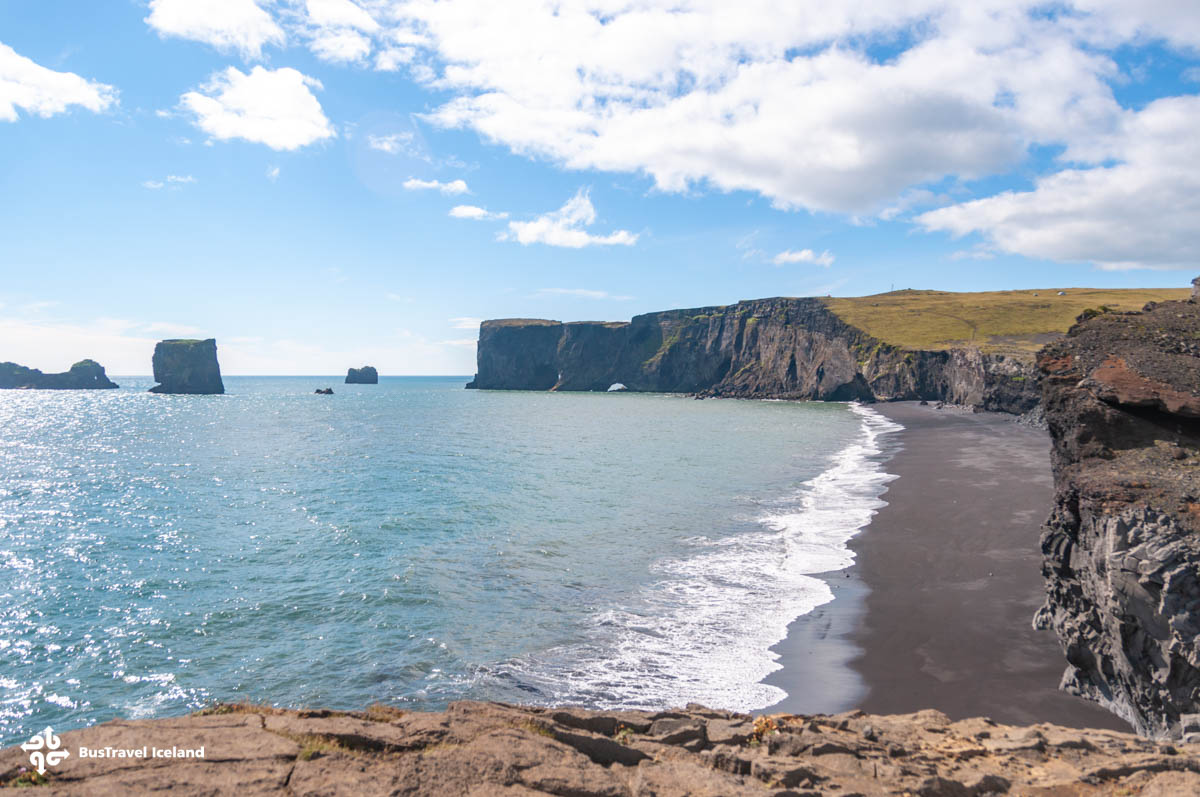
The Dyrhólaey peninsula is a breathtaking combination of nature’s formation and man’s creation. Carved by relentless coastal erosion, this colossal stone bridge offers awe-inspiring views of the nearby Reynisfjara Beach. Atop the endpoint of the Dyrholaey peninsula, a picturesque white lighthouse awaits, while in summer, the arch and cliffs transform into a vibrant birds’ paradise. Against the backdrop of silver-topped mountains, the extensive southern shore unveils the unimaginable beauty of Iceland.
For me, every visit to Dyrhólaey unveils a distinct charm that intimately interacts with the weather. Under a cloudy sky, Dyrhólaey exudes a somber and solemn ambiance, while on sunny days, its vibrant colors come alive with unparalleled intensity. The diverse surrounding landscapes never cease to surprise me. As a photographer, I can’t think of a more picturesque location that offers such dynamic shooting opportunities as Dyrhólaey.
Now, I want to take you into the world of the majestic Dyrholaey Arch and Cliffs, discovering its wonders and essential information for your visit.

The Features of Dyrhólaey Arch and Cliffs
Shaped by the unstoppable forces of wind and sea, Dyrholaey is an iconic geological formation that showcases the diverse and mesmerizing southern part of Iceland.
Dyrhólaey, a 120-meter high promontory near Vík, derives its name from the massive arch sculpted by the sea. During calm conditions, some boats can navigate through it, and an audacious pilot once flew a small aircraft through the arch.
From the Dyrhólaey’s top, a fantastic view unfolds. The headland, believed to have emerged from an underwater volcanic eruption during the glacial period, features numerous sea outcrops. The tallest among them, known as Háidrangur (“High column“), reaches a height of 56 meters. Designated as a natural reserve in 1978, Dyrhólaey stands as a testament to Iceland’s commitment to preserving its remarkable natural heritage.

Dyrholaey Surroundings
Stretching gracefully into the vast expanse of the North Atlantic Ocean, this rugged bridge-like formation offers a panoramic view that covers some most mesmerizing landscapes.
To the north, the Mýrdalsjökull glacier captivates with its silver icecap, extending as far as the eye can see. Turning eastward, the ancient shapes of the black lava sea stacks known as Reynisdrangar rise from the restless sea, steeped in stories and folktales. And towards the west, a lengthy coastline unfolds, leading the gaze towards the town of Selfoss.

Dyrhólaey stands as a beloved spot for photographers, offering them the opportunity to capture the very essence of Iceland’s nature.
This incredible region offers an array of viewpoints that allow you to fully immerse yourself in its diverse landscapes.
One of the most popular vantage points is atop the Dyrhólaey Peninsula, where you’ll find the striking white Dyrhólaey lighthouse. From this vantage point, you can enjoy the view of the complete form of the remarkable Dyrhólaey Arch, with the world-renowned black sand beach providing a stunning backdrop. The black sands, a defining feature of Iceland’s southern shore, stretch across the coastline, creating an otherworldly and surreal scenery that resembles a different planet.
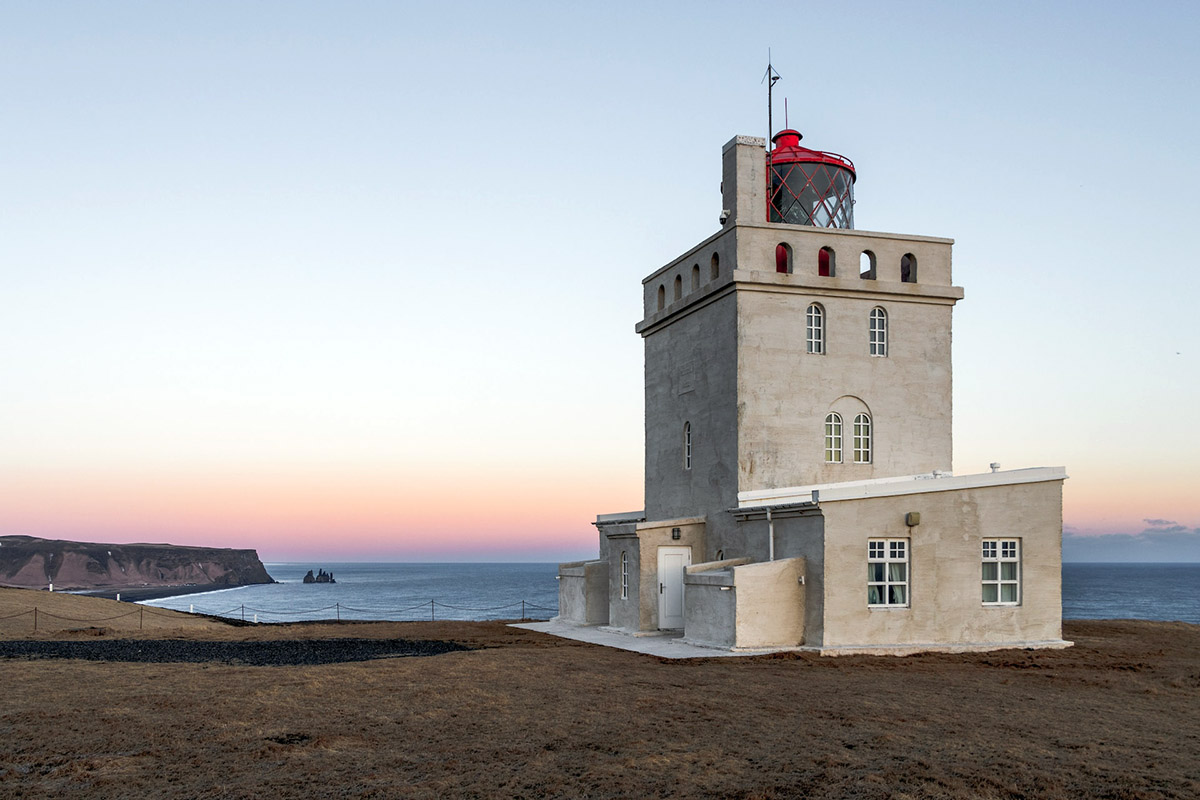
Gazing out over the expansive black sand beach, your eyes will be captivated by a stunning sight—a huge sea stack standing along the shoreline. This remarkable rock formation, known as Arnardrangur or the ‘Eagle Rock,’ demands attention as it confronts the relentless Atlantic waves for thousands of years. It is said that the name Arnardrangur originated from the eagles that once nested atop.
Visiting Dyrholaey is an experience that embraces you in the beauty and uniqueness of this remarkable corner of Iceland.

Wildlife around Dyrhólaey
Nestled on the cliffs of Dyrhólaey, a diverse array of wildlife thrives. The area is a birdlife paradise, offering colorful and diverse sightings. The Atlantic Puffins, with their lovely and photogenic presence in the summertime, find homes in the cliffs. Their vibrant beaks and black-and-white feathers create a beautiful contrast with the rugged surroundings. The elegant eider ducks soar through the sky, their gentle calls resonating in the air.
The cliffs also provide sanctuary for other seabirds, such as guillemots and fulmars. If you are lucky enough, you might even see seals resting on the coastal rocks or swimming in the surrounding waters. The diverse wildlife make the Dyrholaey area a vivid place filled with life in summer.



The best time of year to see these wonderful birds is from May to August. Their nesting season. When you visit, please be mindful that the area is a nature reserve, and crossing the protected area is strongly advised against.
Visiting the Dyrhólaey Arch and Cliffs
Located on the south coast of Iceland, a visit to the Dyrhólaey area conveniently falls along the same route as other popular attractions like Seljalandsfoss and Skogafoss waterfalls, as well as Reynisfjara black sand beach.
There are two major sections to visit in Dyrhólaey, both accessible by car and connected by walking paths.
If you’re starting from Reykjavik, take Road No. 1, also known as the Ring Road, which encircles Iceland. After approximately a 2-hour drive, you’ll reach the intersection of Route 1 and Road 218. From there, continue on Road 218 until you arrive at the parking lot for Dyrhólaey. Please note that the ascent to the parking area is quite steep, so ensure you are fully prepared for the challenge.

Once you arrive at the top of the Dyrhólaey Peninsula, you will find a white lighthouse standing prominently. Walking towards the southern edge, you will reach the viewpoint overlooking the Dyrhólaey Arch. In the summer, the cliffs are home to Atlantic puffins, fulmars, and other seabirds. A walking path leads down to the Reynisfjara viewpoint at a lower elevation, where you can see more rock formations rising from the ocean and the extensive shoreline of the famous Reynisfjara black sand beach. Another notable cliff is located near Arnardrangur, the ‘Eagle Rock,’ which also hosts many puffins during the summer. Exploring the entire area takes more than an hour.
This route provides a picturesque journey, allowing you to explore the wonders of the south coast and eventually reach the breathtaking Dyrhólaey area.
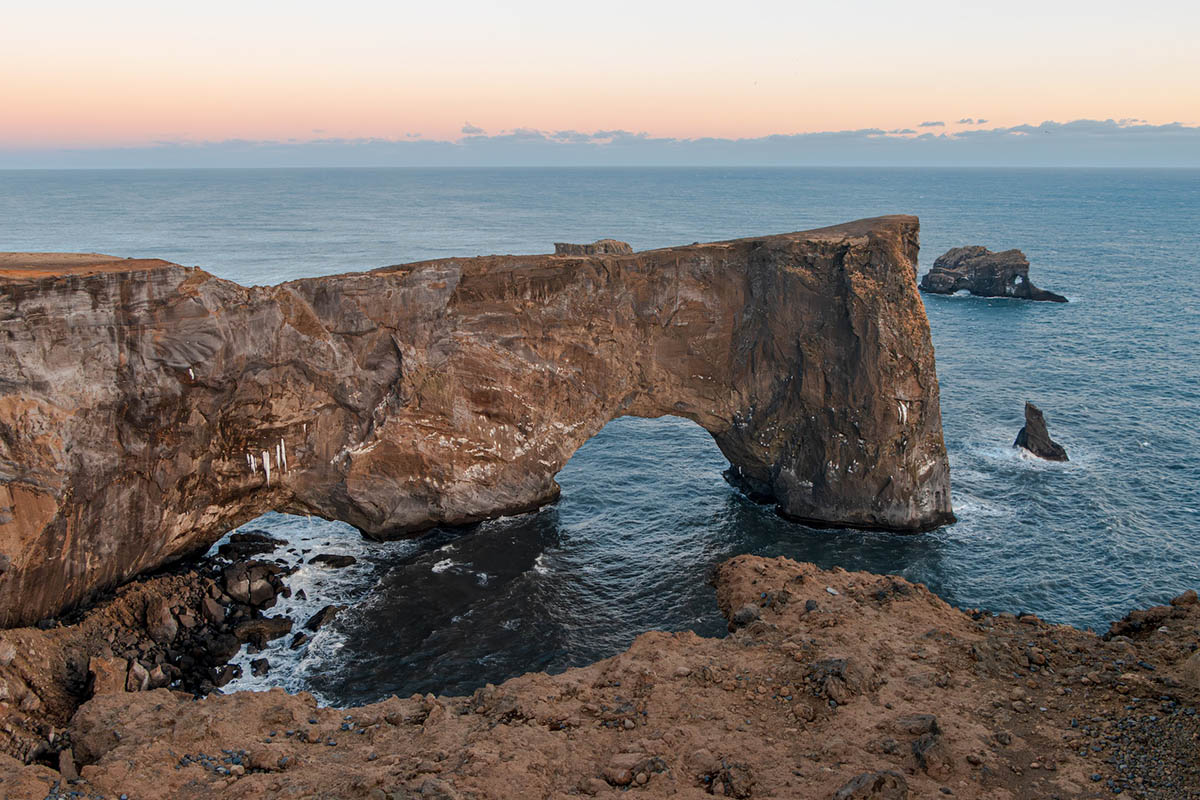
Best time to visit Dyrholaey
The best time to visit the Dyrhólaey area is during the summer months, from May to August. This period offers longer daylight hours, milder weather, and better accessibility to the site. It is also the prime time to observe the vibrant birdlife, including puffins, as they nest in the cliffs during this season.
However, it’s important to note that Iceland’s weather can be unpredictable, so it’s always advisable to check the local forecast and be prepared for changing conditions. Additionally, the Dyrhólaey area is a popular tourist destination, so visiting earlier or later in the day can help avoid crowds and enhance your overall experience.

Why Dyrholaey is A Must-Visit
Dyrholaey arch and cliffs, situated in the heart of South Iceland, offer an enchanting experience that beautifully highlights the region’s best features.
Immerse yourself in panoramic views of the Nordic island’s southern shore, adorned with stunning time-chiseled sea stacks that create an awe-inspiring coastal scene. Be delighted by the presence of charming Puffins and a variety of seabirds that grace the area during the summer months.
With its outstanding viewpoints and captivating ambiance, Dyrholaey stands as a must-visit destination along Iceland’s captivating south shore.

Nearby Attractions from Dyrholaey Peninsula
Reynisfjara Black Sand Beach
One of the world’s most famous black sand beaches, Reynisfjara houses dramatic volcanic black sand, towering basalt columns, and the Reynisdrangar sea stacks. Be cautious of the powerful waves and explore the mystical beauty of the area.

Skogafoss waterfall
This iconic waterfall is one of Iceland’s most famous waterfalls, with its thundering cascade drops from a height of 60 meters (197 feet) and runs 25 meters (82 feet) wide. On sunny days, Skogafoss captures rainbows and the powerful splash can be felt from some distance away. You can hike up to the top for a breathtaking view of the surrounding landscape.

Seljalandsfoss waterfall
Another remarkable waterfall in Iceland’s south region, Seljalandsfoss offers a unique feature: a path that allows you to walk behind the waterfall. Experience the thrill of being surrounded by cascading water and enjoy fantastic photo opportunities.

Solheimajokull Glacier
Explore the awe-inspiring Solheimajokull Glacier, an outlet glacier from the larger Myrdalsjokull glacier, Iceland’s further largest ice cap. Take a guided glacier hike to witness stunning ice formations, deep crevasses, and a captivating frozen landscape.

Vík í Mýrdal
Explore the charming coastal village of Vík í Mýrdal, located near Dyrholaey peninsula. Admire the picturesque Vikurfjara black sand beach, visit the iconic red-roofed church on the hill, and enjoy panoramic views of the Reynisdrangar sea stacks. Vík is also a great base for further exploration of South Iceland.

Best Tours to South Iceland
Discover Iceland’s southern shore in a day from Reykjavik. Though vast, we’ve curated popular attractions for you to explore. You can choose from our suggested itineraries and experience the best of this remarkable region.
South Iceland‘s waterfalls, glaciers, and black sand beach are highlights on the popular route. Although Dyrholaey is not included, its presence can still be admired from a distance. Couch and small group tours run year-round. To visit Dyrholaey, book a private tour for our professional guide to take you there.
Don’t miss Jokulsarlon Glacier Lagoon—a must-visit in Iceland. The trip follows the Ring Road to the southeast, where Vatnajokull dominates and shapes the landscape. It’s the longest day tour, with over 4 hours one way, but the awe-inspiring wonder is worth it. In summer, take a boat tour among massive floating icebergs.
Iceland’s rich geothermal energy offers numerous natural hot springs for relaxation. Combining sightseeing with a geothermal spa experience is a popular choice. Don’t miss the newest addition, Sky Lagoon, after your South Iceland day tour. In winter, join us for a Northern Lights hunt, maximizing your Icelandic experience.

